|
BUILDING THE 1:48 SCALE EDUARD GERMAN HANNOVER CL.II C.9280/17 of FA(A) 282 c. 1917
|
|
ISSUE NUMBER 18 |
HISTORICAL MINIATURES BY GEORGE GRASSE |
MAY 2013 |
HISTORICAL MINIATURES JOURNAL ISSUE NUMBER 18
BY GEORGE GRASSE
|
BUILDING THE 1:48 SCALE EDUARD GERMAN HANNOVER CL.II C.9280/17 of FA(A) 282 c. 1917
|
KIT DESCRIPTION
The Hannover CL.II is built from the mid-90s Eduard 1:48 scale model kit of the Hannover CL.IIIa, the differences being quite minor as explained below. The multi-media kit consists of two injection-molded plastic sprues, a white metal aircraft engine casting, steel tubing for exhaust pipes, pins for engine push rods, a clear plastic sheet for the windscreen, a decal sheet for national and aircraft markings, a photo etch sheet, two 4-color camouflage decal sheets for the pre-printed fabric, upper and under surfaces, pre-fitted, including rib tapes. The kit number is 8008, one of Eduard's first 1:48 scale kits and somewhat rare.
All of the internal cockpit components are built up from photo-etch components which makes for a delicate structure. The camouflage decal sheets are not to my liking so I will substitute them for Microsculpt's MS4804 upper and MS4805 under decal sets of 4-color pre-printed camouflage fabric. The instruction pamphlet is good. If you are building one of the two kit versions using kit decals, the full-color marking and painting guide is useful.
|
ILLUSTRATION 2: Extract from Eduard Kit 8008 Marking & Painting Guide Showing a Typical Camouflage Scheme |
|
|
|
|
Not supplied in the kit and augmented or replaced are following after-market accessories:
|
ILLUSTRATION 3: Hannover CL.IIIa Three-View Drawing |
|
|
|
This three-view drawing was prepared by L. E. Bradford and appeared in Gray & Thetford's German Aircraft of the First World War. Note the over-lapping of the ailerons which were contoured to fit the wing design on the CL.II. Otherwise, the profiles above are a match. 1 |
GERMAN CL-TYPE AIRCRAFT
The CL-Type classification, as explained for the Halberstadt CL.II in my HM Journal Issue 14 and Halberstadt CL.IV in my HM Journal Issue 17, were originally designed as two-seat escort aircraft for FA and FA(A) two-seaters on missions such as photography, reconnaissance, and artillery spotting, collectively known as army co-op missions. The CL-Types were initially assigned to Schutzstaffeln (Schustas) for this purpose and usually stationed at or near the Flugplatz (aerodrome) of the unit it served. The Hannover CL.II was the first of this type and 15 or so were serving at the front by August 1917. Their early appearance as compared to the Halberstadt design was due, in part, to the incorporation of the Argus As.III 180 hp engine, in surplus because its operating performance at altitudes above 10,000 feet fell off drastically. The Halberstadt CL.II was to be powered by the Mercedes D.IIIa engine which remained in high demand and, as a result, was in a state of rationing primarily to fighters. Its performance was superior above 10,000 feet. However, the close escort duty envisioned for the CL-Types meant that their operating ceiling would be well under 10,000 feet and Argus As.III was a wise choice by Hannover as shown in Illustration 3 above.
HANNOVER CL-TYPES COMPARED
The Hannover CL.III and IIIa were slightly improved versions of the CL.II. The Hannover CL.III was an attempt to use the Mercedes D.IIIa engine which was then a high priority engine for fighters. Few were allocated to the Hannover CL.III program so the design reverted back to the Argus As.III engine and was built as the Hannover CL.IIIa. The CL.III/IIIa series had modified wingtips which incorporated horn balanced ailerons. The profile of the CL.III is noticeably different than the CL.IIIa due to the different engines. However, when comparing the CL.II to the CL.IIIa, the differences are not readily noticeable in profile because both used the Argus As.III engine, the same fuselage, and tail unit. To convert the Eduard kit from a CL.IIIa to the CL.II is not difficult because the CL.II has a continuous plain upper wing tip with the aileron blending in whereas the CL.IIIa had protruding horn balanced ailerons. One other Hannover CL.II (Rol) was produced. This was a school machine built by LFG Roland in a production run of 200 aircraft equipped with the Argus As.III engine.
HANNOVER CL.II, III, and IIIa DESCRIBED
The Hannoversche-Waggonfabrik A. G. or "Hawa" of Hannover-Linden was, up to WW1, a manufacturer of railway rolling stock. Germany realized the need to develop a large air force and invited a number of experienced non-aviation manufacturers to develop aircraft construction technology. This developed in 1915 and manufacturers that accepted the challenge were weaned on license-built production runs. Hannover was one of the companies that developed a competent in-house aircraft design and development capabilities. Finally, in April 1917, Idflieg (the German aircraft inspectorate) awarded "Hawa" a contract to build three prototypes of their promising CL.II design.
One of the issues that plagued all German aircraft manufacturers was the insufficient production rate of high quality aircraft engines especially the Mercedes D.III family. Germany could build more aircraft than engines largely because engines required all machined parts and qualified machinists were at a premium. So, it was decided to utilize the second-rate Argus As.III engine which was in supply. It sounds devastating but the As.III was as good or better a performer at altitudes under 10,000 feet, the height at which the CL-Types were to operate. This was proved during the Typenprüfung (type testing) process in which one prototype model was extensively flight tested in the air, another was extensively tested in the "lab", and the other was a spare. After testing was approved, Idflieg placed an initial order for 200 Hannover CL.II aircraft in August 1917.
The single most identifiable feature of Hannover CL-Types is the biplane horizontal tail only seen on heavy, multi-engine bombers. The purpose in the Hannover CL design was to reduce the overall dimensions of the tail unit to improve the defensive field of fire from the turret-mounted rear Parabellum machine gun. This was a significant feature and, when coupled with the Hannover's exceptional maneuverability, proved to be one of the most dangerous German two-seaters to attack from any angle.
The fuselage was an all-wood structure built up from two longerons on each side attached to wood formers. The whole was covered in plywood, itself covered in doped fabric. The fuselage was typically narrow, but the cockpit area was especially high giving the Hannover a relatively high, narrow cross section. This was done not only to provide for more room but to bring the fuselage height nearly to the level of the top wing. This enhanced the rear gun's defensive radius. The fin was an integral part of the fuselage. The rudder, top horizontal stabilizer, and both elevators were welded steel tubing covered with fabric. The bottom horizontal tailplane, like the fin, was ply then fabric covered. The top and bottom elevator pairs were originally braced with outward struts but these were deleted on later CL.II when an internal bracing structure was added.
The wings were wood-framed and fabric-covered. The earlier Hannover CL.II had clean, rounded top wing tips but the welded steel tube ailerons on the CL.III/IIIa were made to overlap this profile increasing the pilot's ability to easily roll the aircraft giving it the agility of a fighter.
When the CL.II was given over to the CL.III, the 180 hp Argus As.III was replaced by the 160 hp Mercedes D.III, now deemed important enough for this type. Two-hundred CL.IIIs were ordered but only 80 were finished since the 160 hp Mercedes D.III was supplanted by the 180 hp Mercedes D.IIIa and these engines were high priority for fighter production. After the first 80 CL.III, the Argus As.III was reconsidered. Adjustments were made to the forward fuselage to take the As.III and subsequent production aircraft were re-typed as the Hannover CL.IIIa.
The landing gear struts and wing struts were steel tubing with wood fairings covered in doped fabric. The simple ash tailskid followed the design line of the bottom fin. The cockpit was configured to take all manner of aviation equipment (photography, telegraphy) and ammunition for the Parabellum. 2
HANNOVER CL.II and IIIa SPECIFICATIONS COMPARED
Specifications for the early CL.II compared to the later CL.IIIa are shown below in Table 1.
Additional and more detailed specification data and component drawings can be found in the British Ministry of Munitions "Report on the Hannoveraner Biplane" reproduced in Cross & Cockade (US), Volume 3, Number 2. The subject of the report was G #156, Hannover CL.II serial C.13199 of an unknown unit brought down by AAA fire over Lestrum on 29 March 1918. The crew is unknown and no casualties for this date match. 3
With regard to sources for specifications, there are three: 1) Windsock Datafile 23 Hannover CL.III (Peter Grosz); 2) German Aircraft of the First World War (Gray & Thetford); and Ministry of Munitions Report on the Hannoveraner Biplane (Cross & Cockade US, Vol. 3, No. 2). However, these sources vary as to the specific CL-Type covered or they present data in differing measurement systems, or, in the case of performance, use different altitudes in their calculations. The reader is referred to these sources rather than present a complicated table here.
Several interesting observations are here quoted from the Ministry of Munitions report: "The performance of the machine is not by any means bad. The machine is nose-heavy with the engine off, and slightly tail-heavy with the engine on. It tends to turn to the left with the engine on. The machine is generally light on controls, except that the elevator seems rather insufficient at slow speeds. It is not tiring to fly, and pulls up very quickly on landing. The view is particularly good for both pilot and observer. The former [the pilot] sits with his eyes on a level with the top plane [wing], and also enjoys a good view below him on account of the narrow chord of the lower plane [wing]."
HANNOVER CL-TYPES PRODUCTION
Table 1: Hannover CL.II, III, and IIIa Production Orders and Serial Numbers 4
| Order Date | Quantity | Type | Serial Number Range | Notes |
| May 1917 | 3 | CL.II | C.4500 - 4502/17 | Prototypes 5 |
| August 1917 | 200 | CL.II | C.9200 - 9399/17 | First Production Batch |
| September 1917 | 243 | CL.IIIa | C.13075 - 13317/17 | Second Production Batch * |
| September 1917 | 57 | CL.IIIa | C.13318 - 13374/17 | Replacements for destroyed CL.II aircraft in fire on 1 March 1918 |
| January 1918 | 80 | CL.III | C.16000 - 16079/17 | Third Production Batch ** |
| January 1918 | 120 | CL.IIIa | C.16080 - 16199/17 | |
| February 1918 | 200 | CL.II (Rol) | C.500 - 699/18 | Subcontracted - built as trainers*** |
| April 1918 | 200 | CL.IIIa | C.2600 - 2799/18 | Fourth Production Batch |
| May 1918 | 100 | CL.IIIa | C.3800 - 3899/18 | Fifth Production Batch |
| June 1918 | 100 | CL.IIIa | C.6950 - 7049/18 | Sixth Production Batch |
| September 1918 | 50 | CL.IIIa | C.12620 - 12669/18 | Seventh Production Batch |
| Total CL.II, III, IIIa | 1353 | - | - | Includes combat and trainer aircraft |
Rol = Luftfährzeug Gesellschaft (LFG Roland)
|
* Peter M. Grosz notes that on 1 March 1918, one Hannover factory building was destroyed by fire including 57 or 61 Hannover CL.II aircraft. These were replaced by 57 CL.IIIa models at a later date as shown above. ** These were the only CL.III versions built with the Mercedes D.IIIa engine so the contracted was completed as CL.IIIa aircraft with the Argus As.180 engine. *** CL.II (Rol) designation "Rol" = Luftfährzeug Gesellschaft (LFG Roland) - used as an advanced two-seater trainer which were painted white as were all such aircraft operating on the home front. |
HANNOVER CL-TYPES AT THE FRONT (The following paragraphs and table previously appeared in my Journal No. 17 and is repeated here for its applicability.
The actual number of aircraft on hand (Frontbestand) was collected from all major command levels probably on a weekly basis. The most widely recognized research into these numbers was by Peter M. Grosz who published his findings in his regular feature entitled Archiv: Frontbestand, The Journal of the Early Aeroplane "WWI Aero", issues 107 (Dec 1985) and 108 (Feb 1986). For the month ending October 1918, Peter M. Grosz could not accumulate a complete set of reports for this period and attributes the incomplete data to the German retreat and collapse of the Western Front in late October and November 1918 when substantial record keeping was lost, destroyed, or, if captured, so far has not turned up.
There were 38 Schlastas operating in the second half of 1918 each of six CL-Type aircraft, probably with a few minor exceptions. At full strength, this would amount to 228 aircraft plus a guess of 33% or 75 more aircraft of that number held at the various army aviation parks available for immediate replacement giving a total requirement to maintain full strength of 303. FA and FA(A) units also used CL-Type aircraft and those with increased authorization of nine aircraft probably carried at least one and a half (average) on hand for their own escort missions. The number floating around various publications give the increased or Verstärkt units at 38 as of late 1917. Probably more were authorized but again, perhaps not. So, taking 38 multiplied by 1.5, FA and FA(A) units would have 57 CL-Types at their airfields with another 33% or 19 more held in the army aviation parks in reserve for a total FA and FA(A) count of 76 aircraft. The combined total for all aviation units using CL-Type aircraft could be estimated at 379 aircraft required to maintain full strength. Note in Table 2 below that from the beginning of 1918 through the end of October 1918, the average number of 621 aircraft at the front! The likely answer is a higher number of aircraft in the system to account for a high loss rate (combat and accidents) related to low-level ground attack missions. It is possible to assume that a 100% replacement rate per month might have been used to calculate how many CL-Types would have to be supplied from Halberstadt and Hannover (and their licensed partners) each month.
Table 2: Front Line Inventory of CL-Types 1917-1918 6
|
CL-Type |
1917 |
1918 |
||||||||||
|
Feb |
Apr |
Jun |
Aug | Oct | Dec |
Feb |
Apr |
Jun |
Aug | Oct | Dec | |
|
Halberstadt CL.II |
0 |
0 |
0 |
0 | 0 | 170 |
224 |
342 |
311 |
175 | ? | - |
|
Halberstadt CL.IV |
0 |
0 |
0 |
0 | 0 | 0 |
0 |
0 |
0 |
136 | ? | - |
|
Hannover CL.II |
0 |
0 |
0 |
0 | 0 | 162 |
295 |
249 |
72 |
31 | ? | - |
|
Hannover CL.III |
0 |
0 |
0 |
0 | 0 | 0 |
0 |
109 |
159 |
233 | ? | - |
|
Hannover C.IIIa |
0 |
0 |
0 |
0 | 0 | 0 |
0 |
51 |
67 |
29 | ? | - |
|
Total of CL-Types |
0 |
0 |
0 |
0 | 0 | 332 |
519 |
751 |
609 |
604 | ? | - |
This project will use the Eduard kit for the Hannover CL.IIIa and converted to build the Hannover CL.II C.9280/17 of FA(A) 282 flown by Flugzeugführer Unteroffizier Gfrör (P) and Leutnant Grönhagen (O), based at Sierenz, on the Western Front, during the winter of 1917/1918..
My reason for building the model as a Hannover CL.II fits my rule of knowing the crew, unit, serial number, markings, date, and circumstances. I generally prefer the Eisernes Kreuz (Iron Cross) insignia over the late-war Balkenkreuz insignia. Lastly, the conversion is quite simple because the distinguishing features of the CL.II and CL.IIIa are, at first sight, nearly indistinguishable. The features are 1) the ailerons; 2) the vertical tail struts; 3) and minor measurements as to fuselage and flying surface dimensions..

Hannover CL.II C.9280/17 from Das Propellerblatt, Nummer E.1, 2006. Ltn Grönhagen (O) standing in the observer's cockpit, Uffz Gfrör (P) standing between the two mechanics assigned to this aircraft.7
My interest in this specific Hannover CL-Type sprung from research in issues of the German aviation periodical Das Propellerblatt devoted to early German aviation up to 1920. I first ran across C.9290/17 in issue Nummer E1 of 2006 which was devoted to the life Ltn Karl Robert Kerner who served as an observer (Beobachter) in FA(A) 282. The article in that issue and most of the photos were produced by a current relative, Walther Kerner Hamburg. My primary interest is German FA and FA(A) two-seater units and aircraft. This issue had a compelling number of photos that substantiated the composition of these units by the last full year of the war. That is, FA(A) 282 was NOT one of late-1917 front-line divisional verstärkt units that had their airplane inventory increased from six to nine aircraft. FA(A) 282 retained their allotted number of six aircraft. More than likely, this meant that FA(A) 282 was a "corps" and not a "division" unit. The difference between the two is that "corps" level units were responsible for the larger corps sector and spotting for corps artillery. Division units were assigned directly to divisions in the front line and its immediate sector and spotting for divisional artillery.
Two of the more remarkable photos in issue Nummer 1, is "left hand" line up of three aircraft on page E.22 and the "right hand" line up of the other three aircraft on page E.24. The aspect from which the photographer took the photos, the direction of the shadows, the general look of the sky, and the leaf-less tree line suggested to me that these two photos captured FA(A) 282s inventory. These aircraft are: Rumpler C.IV (two - of which one is a "Höhenaufklarer" or high-flying, deep-penetration photo recon machine with the large Maybach Mb.IV 240 hp engine), DFW C.V (three), and Hannover CL.II C.9280/17 which could be used as an escort to any of the others depending on the expectation of Allied aircraft interception.
A total of three photos in this article were of C.9280/17. As usual in Das Propellerblatt, the back outside cover is adorned with three color profiles of aircraft found in that issue. One of the profiles was C.9280/17 by Walter Werner with the caption dated February 1918 (the caption incorrectly says February 1917). The fuselage features the vague hand-painted multi-color factory scheme over-sprayed with a dark wash that appears to be dark Prussian blue. A prominent black outlined white comet is the crew's personal insignia and Eisernes Kreuzen are seen on the fuselage and rudder. A faint color band around the fuselage was interpreted to be all black. 8
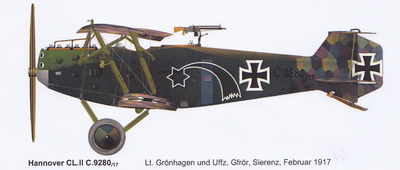 |
| The original image by Walter Werner of CL.II C.9280/17 from Das Propellerblatt, Nummer E.1, 2006. Note the black comet motif, the dark colored fuselage band, solid color struts, and the dark overspray with little of the original hand-painted camouflage showing at the rear of the fuselage and vertical fin... |
At the time I reviewed this issue a few years ago, a Hannover CL-Type in 1:48 scale was not available. Just about a year ago, the old Eduard EU8008 kit discussed in the previous panel became available to me. So, I resurrected my research materials. Coincidentally, Das Propellerblatt sent me their belated Nummer M4 issue of 2010. It's a publication dedicated to the modeling aspect of World War I aviation. On the outside back cover there appeared three color profiles of C.9280/17. Looking inside, I found an article written by Henning Oppermann who took the responsibility to seriously challenge the color profile interpretation in Nummer E1 done in 2006. 9
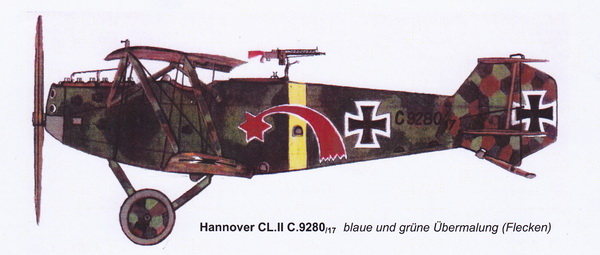 |
|
Henning Oppermann's Green/Blue version of Hannover CL.II C.9280/17 from Das Propellerblatt, Nummer M.4, 2010,offering the alternating dark green and Prussian blue overspray. Note the new interpretation of a white-outlined red comet, the yellow fuselage band, multi-colored struts, and the dark green/Prussian blue overspray.. |
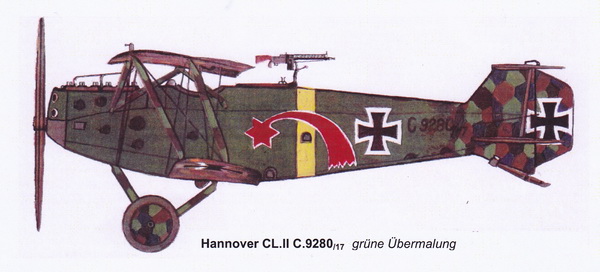 |
| Henning Oppermann's overall Green overspray version of Hannover CL.II C.9280/17 from Das Propellerblatt, Nummer M.4, 2010. |
 |
| Henning Oppermann's overall Prussian Blue overspray version of Hannover CL.II C.9280/17 from Das Propellerblatt, Nummer M.4, 2010. |
Without going into details, the scheme of C.9280/17 was given presented in three possibilities known to have been applied to various Hannover C-Types. Essentially, it is the thinned down overspray that could have been one of three possibilities: 1) large alternating patches of dark green and Prussian blue, fore to aft; or, 2) dark green overall; or, 3) Prussian blue overall.
All of the Oppermann images feature the following interpretations: 1) the dark color band encircling the fuselage just aft of the observer's cockpit was presented as yellow which is one of those oft mistaken shades due to the nature of the black and white film then in use; 2) the comet motif was presented as red outlined in white; 3) the wing and landing gear struts were interpreted as alternating patches of two or three colors, possibly light green, dark green, and brown. I chose to do the latter: an overspray of Prussian Blue.
MODEL CONSTRUCTION
As with all aircraft I build, I maintain a "construction" page for each one in my "World War I Aircraft in 1:48 Scale" section. Click on the link below for the Hannover CL.II model build.
HANNOVER CL.II C.9280/17 FINISH & MARKINGS
Factory-applied pre-printed camouflage fabric was mandatory for frontline combat aircraft. Plywood-covered surfaces were treated with various schemes to blend in with the fabric camouflage and varied greatly in style and colors used from manufacturer to manufacturer. For example, the Halberstadt CL.II used a daylight scheme of 5-color fabric. The plywood fuselage and center sections were hand-painted in various colors then over-sprayed with light-colored specks to enhance blending for camouflage purposes (click here to view my Halberstadt CL.II or Halberstadt CL.IV in these patterns).
The Hannover CL.II followed a similar camouflage finish procedure except that the over-sprayed "specks" were substituted for a thin overspray of one of three schemes: 1) Prussian Blue overall; 2) Dark Green overall; or, 3) a combination of alternate patches of Prussian Blue and Dark Green. This spray was fairly thin and intended to cause or allow the underlying camouflage pattern to be blended and not stark patches of color. In my section above entitled "MODEL TO BE BUILT", I explain the interpretation of the photo of 9280/17 by the artists Walter Werner and Henning Oppermann. I chose Oppermann's interpretation in the all-Prussian Blue overspray.
PREP FOR PAINTING
Hannover CL.II aircraft were finished in an overall 4-color pattern using two methods. The flying surfaces except those noted below were covered in 4-color pre-printed camouflage fabric. The fuselage, lower horizontal stabilizers, vertical fin, and the top wing's center section were plywood-covered and their camouflage was hand-painted at the factory. I consulted a number of photographs of the first production batch of the Hannover CL.II C.9200 - 9399/17 to get a general idea of how the camouflage was applied to the plywood surfaces. It is well documented in these photos that large patches were started at the front of the fuselage and became progressively smaller as the tail was approached. The smaller patches were intended to match closely the pattern of the pre-printed fabric covering tail surfaces. I reasoned that the factory painters probably used close approximations of the shades on the fabric covered surfaces. Note that the wing center section and horizontal tail have both an upper and under surface area that needs to be painted in their corresponding sets of colors, e.g. the upper and under surface shades to match the pre-printed camouflage. I started the process by priming all parts with Tamiya's TM7064 Fine Gray Primer. I then hand-painted these components with Misterkit MKGC10 Clear Doped Linen.
FINISHING THE FUSELAGE
1) The underside of the fuselage was painted with Vallejo VC0912 Sand Yellow to represent that part of the fuselage in its natural varnished plywood finish. This photo shows the clean semi-gloss finish of Misterkit paint.

2) I drew a camouflage pattern on the fuselage to serve as a guide to hand-painting the 4-color camouflage.
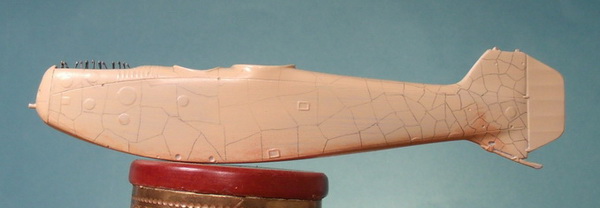
3) Using the colors from Table 4 below, I started at the front and hand-painted irregular patches. Just past the observer's cockpit I started to reduce the size of the patches. From this point on, they need to roughly match the Microsculpt decals in size.
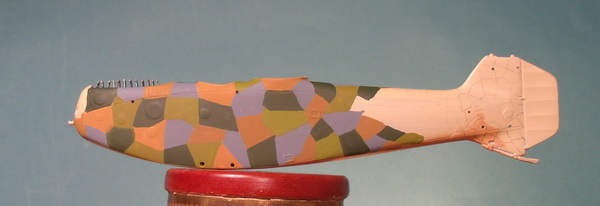
4) The photo below shows the completed hand-painted fuselage camouflage. The rudder is covered with the Microsculpt decal. Note how the smaller patches of the hand-painted fin blend in. At this stage, all metal parts such as access panels and landing gear struts are painted light gray-green. Wheel covers were finished in small circular cuts of Microsculpt decals.
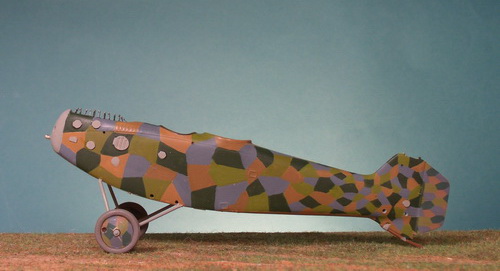
FINISHING THE FLYING SURFACES
5) Before applying pre-printed camouflage decals, I painted the other ply-covered surfaces, namely the wing center section and the tail's lower horizontal stabilizers. Note that both of these components have upper and under surfaces that need to be painted in their corresponding sets of colors to match the upper and under surface shades of the pre-printed camouflage fabric. This next photo shows the hand-painted upper surface of the wing's center section with adjacent Microsculpt decals applied. When viewing photos of Hannover CL.II aircraft, the pattern of the top wing's hand-painted center section seemed larger with little attempt at trying to blend in the the size on the fabric-covered surfaces.
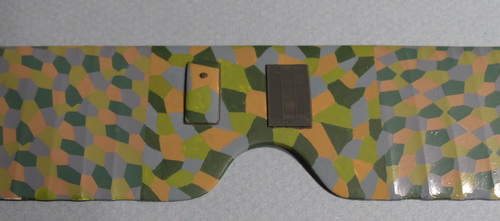
6) The upper and under surfaces of the top wing center section were hand-painted in similar fashion as done to the fuselage. These surfaces were ply-covered. The under surface had to have its 4-color set camouflage paints to match the Microsculpt under surface decals. The photo immediately below shows how the hand-painted colors were applied to the upper surface. Not shown is the lower horizontal tail also ply-covered. See Table 5 below for under surface paint details.
7) The Microsculpt decals for the flying surfaces were applied next. To start the finishing process I first had to apply pre-printed camouflage decals. The Eduard kit included a full set of pre-cut decals but the colors did not seem correct to me. Instead, I substituted Microsculpt's 1:48 scale 4-color upper and 4-color lower decals. To ease the cutting out of the decals from the strips provided, I burned a copy of the multi-view drawings by Ian Stair in the Albatros Productions Windsock Datafile 23 of the Hannover CL.III. 9
8) The third step was to determine the two sets of colors I will need. I based my choices on the pre-printed camouflage decal sheets I would use on the flying surfaces, specifically, Microsculpt's 1:48 scale 4-color decals: MS4804 Four-Color Pre-Printed Camouflage Decals (upper surfaces) and MS4805 Four-Color Pre-Printed Camouflage Decals (under surfaces). Four upper surface colors are shown in Table 3 and four under surface colors are shown in Table 4.
| THE FOLLOWING HAND-PAINTED COLORS IN TABLES 3 AND 4 BELOW WERE MATCHED TO THE FINISHED UPPER SURFACE AND UNDERSURFACE MICROSCULPT CAMOUFLAGE DECALS USED ON THIS MODEL THE PURPOSE BEING TO MATCH FACTORY APPLIED HAND-PAINTED SECTIONS OF THE ACTUAL AIRCRAFT AND AS TOUCH-UP TO THE DECAL WORK IN CASE OF DAMAGE. I DO NOT REPRESENT AN ATTEMPT TO QUALIFY THEM AS THE "REAL THING". NAMES OF THE COLORS ARE MINE. |
Table 3: Paint Swatches for the Hand-Painted 4-Color Upper Surface Colors
| Swatch |
4-Color Upper Surface Name |
Color and/or Mix Used |
.jpg) |
Blue-Gray |
Vallejo VC0900 French Mirage Blue |
.jpg) |
Dark Green |
Vallejo VC0823 Luftwaffe Camouflage Green |
.jpg) |
Ochre Brown |
Vallejo VC0824 German Camouflage Brown Ochre |
.jpg) |
Light Green |
Vallejo VC0857 Golden Olive (3 parts) plus Vallejo VC0921 English Khaki (2 parts) |
Table 4: Paint Swatches for the Hand-Painted 4-Color Under Surface Colors
| Swatch | 4-Color Under Surface Name | German 4-Color Name |
.jpg) |
Pale Pink |
Vallejo VC0944 Old Rose (2 parts) and Vallejo VC0989 Sky Grey (1 part) |
.jpg) |
Pale Blue |
Vallejo VC0901 Pastel Blue |
.jpg) |
Pale Gray |
Vallejo VC0884 Stone Grey |
.jpg) |
Pale Yellow |
Vallejo VC0912 Tan Yellow ( 1 part) and Vallejo VC0953 Flat Yellow (1 part) |
OTHER COLORS
For the cockpit interior I used a number of different shades of light brown with different washes. The pilot sat on a brass main fuel tank. The observer sat on a spring-loaded flip-down seat and supported by a wood or metal leg. For interior details I used the kit's components which were sparse. Most of the Hannover CL-Type aircraft were supplied in ones and twos for the purpose of escorting their own Army co-op units but some were outfitted for those roles as well. I added a few components but not the full complement found on Army co-op aircraft.
Table 5 below gives examples of the colors I used for the model except for the hand-painted 4-color scheme on the fuselage and top wing center section the colors of which are shown in Tables 3 and 4 above. The following are swatches I made from the actual paint, scanned in, and formatted. The actual shades will vary on your computer. Eisernes Kreuz markings were decals placed on all eight of the traditional positions. The serial number, yellow fuselage band, and the comet insignia for this aircraft were decals that I made. Underneath, near the tail is my small font personal marking "G. Grasse - Hannover CL.II - No. 6899".
Table 5: Paint Color Swatches of General Colors for the Hannover CL.II
 |
Misterkit MKGC10 Clear Doped Linen |
Applied as a base color on all 5-color camouflage surfaces |
 |
Misterkit MKGC10 Light Gray/Green | Applied to the metal parts not otherwise covered by camouflage paint |
 |
Vallejo VC0912 Sand Yellow |
Applied to underside of fuselage and underside of the top wing's center section to simulate the clear varnished plywood surface |
 |
Vallejo VC0941 Burnt Umber |
Thinned with water and applied as a wash to cockpit interior wood components |
 |
Vallejo VC0913 Yellow Ochre |
These shades were used on various wood components in the cockpit area mainly to differentiate one from another, e.g. longerons, formers |
|
|
Vallejo VC0824 Camouflage Orange Ochre |
|
 |
Vallejo VC0981 Orange Brown |
HANNOVER CL.II C.9280/17 of FA(A) 282 FINISHED PHOTO GALLERY
|
|
|
 |
 |
 |
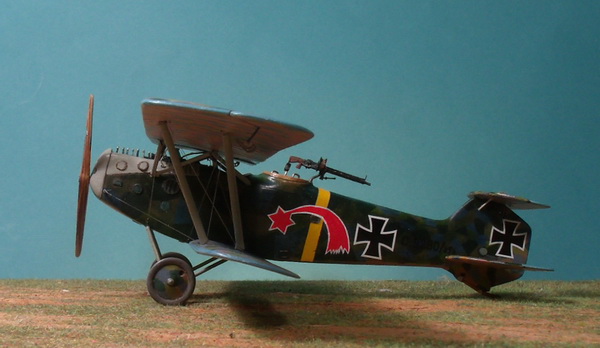 |
------------------------------------- FINIS --------------------------------------
FOOTNOTES
1 Gray, Peter & Owen Thetford, German Aircraft of the First World War, drawing by L. E. Bradford, page 153.
2 Gray & Thetford, pages150-152.
3 Wischnowski, Ed. Report on the Hannoveraner Biplane (reproduced), Cross and Cockade (US), Vol. 3, No. 2. This report includes a number of photos but they are poor at best. Consult Windsock Datafile #23, page 8 for two clear photos.
4 Grosz, Peter M. Hannover CL.III, Windsock Datafile 23, Albatros Productions.
5 During World War I, the German aircraft industry was required to provide three pre-production aircraft for test. One was used for flight testing, one was used for load testing, and one was a spare test aircraft.
6 Grosz, Peter M. Archiv: Frontbestand. This date was taken from The Journal of the Early Aeroplane "WWI Aero", issue 107, Dec 1985.
7 Hamburg, Walther Kerner. Beobachter bei der FA(A) 282 Karl Robert Kerner - Skizze eines Lebens. The photo appears on page E.24 along with one other above it showing 9280/17 before any individual markings were applied. Another photo on page E.27 shows the crew in front of 9280/17 which also is without unit markings.
8 Oppermann, Henning. Hannover CL.II C.9280/17 Color Profiles. Das Propellerblatt Nummer M4 2010, page M4.44. Also note that the shooting comet is now red outlined in white and the fuselage band is yellow probably with a thin black border.
9 Grosz, Peter M. Hannover CL.III, Windsock Datafile 23. Note that there are two sets of drawings by Ian Stair: 1:72 and 1:48 scale.
BIBLIOGRAPHY AND RECOMMENDED READING LIST:
Duiven, Rick and Dan-San Abbott. Schlacht-Flieger!. Atglen, PA: Schiffer Military History, 2006.
Gray, Peter and Owen Thetford. German Aircraft of the First World War. London: Putnam & Company, 1962.
Grosz, Peter M. Archiv: Frontbestand. The Journal of the Early Aeroplane "WWI Aero", issues 107 (Dec 1985) and 108 (Feb 1986).
Grosz, Peter. M. Hannover CL.III Windsock Datafile 23. Berkhamsted, UK: Albatros Productions, Ltd, 1999, revised second edition.
Hamburg, Walther Kerner. Beobachter bei der FA(A) 282 Karl Robert Kerner - Skizze eines Lebens. Das Propellerblatt Nummer E1 2006. Friedrichshafen, Germany: IGL Das Propellerblatt, 2006.
Oppermann, Henning. Hannover CL.II C.9280/17 Color Profiles. Das Propellerblatt Nummer M4 2010. Friedrichshafen, Germany: IGL Das Propellerblatt, 2010.
Sumner, Ian. German Air Forces 1914-18, Osprey Elite Series No. 135. Botley, Oxford (UK): Osprey Publishing Ltd, 2005.
GO TO?